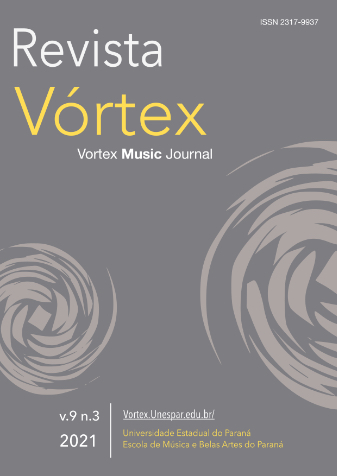Sound feedback control model for live electronic performance in the Ecos Study
DOI:
https://doi.org/10.33871/23179937.2021.9.3.3Palavras-chave:
Acoustic Ecology, Emergence Theories, Audible Ecosystem, Live Electronics, Feedback ControlResumo
Through the Ecos Study we investigate possibilities for musical structuring based on theories of emergence, finding a fertile territory for experimentations within Agostino Di Scipio's paradigm of Audible Ecosystems. The inclusion of the acoustic environment as an active component of the musical system led us to rethink classical techniques of sound synthesis and modelling, some traditional models of electroacoustic performance, and to criticize the very role of interactions in a qualitative perspective. A positive feedback control model has been developed aiming at understanding the behaviour and the structure of the ecosystem supporting the implementation of the Spatial Instrument, a core element implemented through MAX/MSP patch and that offers a logical rationale for organizing speakers and microphones in the acoustic space. We introduce the underlying theoretical debate and present the feedback control mechanism as the basis from which the Spatial Instrument is developed.Downloads
Referências
AUGOYARD, Jean-François; TORGUE, Henry. Sonic Experience: a guide to everyday sounds. Montreal: McGill-Queen"™s University Press, 2005.
BAALMAN, Marije. Spatial Composition Techniques and Sound Spatialisation Technologies. Organised Sound 15 (3), p. 208-218. Cambridge University Press, 2010.
BORRIAUD, Nicolas. Pós-produção: como a arte reprograma o mundo contemporâneo. Trad. Denise Bottmann. Martins Fontes: São Paulo, 2009.
DI SCIPIO, Agostino. Dwelling in a field of sonic erlationships: instrument and listening in an ecosystemic view of live electronics performance. In: Sallis et al. (ed.). Live electronic music: composition, performance, study. Taylor & Francis: Routledge, 2017.
________________. Listening to yourself through the otherself: on background noise study and other works. Organised Sound 16 (2), p. 97-108. Cambridge University Press, 2011.
________________. Using PD for Live Interactions in Sound: An Exploratory Approach, 2006. Available in <(PDF) Using PD for Live Interactions in Sound. An Exploratory Approach >
________________. Sound is the interface"™: from interactive to ecosystemic signal processing. Organised Sound , 8(3), 269–277. Cambridge University Press, 2003.
DUDAS, Richard; LIPPE, Cort. The Phase Vocoder - part 1. Online article. Cycling74, 2006. Available at < Tutorial: The Phase Vocoder – Part I >
FROMM, Jochen. Types and forms of emergence. Published online at 2005.
GAMPER, David.; OLIVEROS, Pauline. A Performer-Controlled Live Sound-Processing System: New Developments and Implementations of the Expanded Instrument System. Leonardo Music Journal 8, 33-38, MIT Press, 1998.
GREEN, Owen. Audible Ecosystemics as Artefactual Assemblages: Thoughts on Making and Knowing Prompted by Practical Investigation of Di Scipio's Work. Contemporary Music Review, 33:1, 59-70, 2014.
JOHNSON, Steven. Emergência: a dinâmica de rede em formigas, cérebros, cidades e softwares. Rio de Janeiro: Jorge Zahar, 2003.
KARPLUS, Kevin; STRONG, Alex. Digital Synthesis of Plucked-String and Drum Timbres. Computer Music Journal, 7 (2). MIT Press, 1983.
MERIC, Renaud; SOLOMOS, Makis. Analysing Audible Ecosystems and Emergent Sound Structures in Di Scipio's Music. Contemporary Music Review, Taylor & Francis, 2014.
MORIN, Edgar. Introdução ao pensamento complexo. Porto Alegre: Sulina, 2005.
MITCHELL, Melanie. Complexity: a guided tour. Oxford University Press, 2009.
RAFFAELLI, David; FRID, Christopher. Ecosystem Ecology: A New Synthesis. Cambridge University Press, 2010.
SANFILIPPO, Dario; VALLE, Andrea. Feedback Systems: An Analytical Framework. Computer Music Journal, 37 (2), 12-27. MIT, 2013.
SETTEL, Zack. LIPPE, Cort. Real-Time Timbral Transformation: FFT-based Resynthesis. Contemporary Music Review. 10. IRCAM, 1994.
SIMONDON, Gilbert. A individuação í luz das noções de forma e de informação. Trad. Luís Aragon e Guilherme Ivo. São Paulo: Editora 34, 2020.
THOMASI, Ricardo. Ecos n.1, para eletrônica ao vivo e ambiente retroalimentado. In: Anais do Workshop em Música Ubíqua / Proceedings of the Ubiquitous Music Workshop (UbiMus 2018). São João del Rei, MG: Ubiquitous Music Group, 2018.
________________. Feedback control for performing with audible ecosystem. Zenodo.org, 2021. Available at < https://doi.org/10.5281/zenodo.5649265 >
THOMASI, Ricardo; FARIA, Regis R. A. Moving Along Sound Spectra: An Experiment with Feedback Loop Topologies and Audible Ecosystems. Proceedings of the International Computer Music Conference: The Virtuoso Computer. p. 393-397. Pontificia Universidad Católica de Chile: ICMC, 2021
VAGGIONE, Horacio. Composition musicale: représentations, granularités, Émergences. Intellectica, 1 (2), 155-174, 2008.
ROWE, Robert. The aesthetics of interactive music systems. Contemporary music review, 18 (3), 83-87. Taylor & Francis, 1999.
SOLOMOS, Makis. De la musique au son. L"™émergence du son dans la musique des XX e-XXI e siècles. Presses universitaire de Rennes, 2013.
VIEIRA, Jorge A. Ilya Prigogine: entre o tempo e a eternidade. Galáxia, 6, p. 291-299, 2003.
WATERS, Simon. Content and discontent. Performing Technology: User Content and the New Digital Media, p. 145-159. Cambridge Scholars Publishing, 2009.
____________. Performance ecosystems: ecological approaches to musical interaction. Electroacoustic Music Studies Network. De Montford/Leicester University: EMS, 2007.
WILENSKY, Uri; RAND, William. An introduction to agent-based modeling: Modeling natural, social and engineered complex systems with NetLogo. MIT Press, 2015.
Downloads
Publicado
Como Citar
Edição
Seção
Licença
Copyright (c) 2022 Ricardo Thomasi, Regis R. A. Faria

Este trabalho está licenciado sob uma licença Creative Commons Attribution 4.0 International License.
Autores mantêm os direitos autorais e concedem à revista o direito de primeira publicação, com o trabalho simultaneamente licenciado sob a Licença Creative Commons Attribution que permite o compartilhamento do trabalho com reconhecimento da autoria e publicação inicial nesta revista.






